Store your oils properly by choosing amber or cobalt blue glass bottles for maximum UV protection and freshness. Keep them in a cool, dark place at 55-60°F, away from heat sources and direct sunlight. Always use clean, dedicated utensils and guarantee tight seals to prevent oxidation. Implement a labeling system and regularly check for signs of spoilage. These fundamental practices will help you avoid costly waste and discover the secrets of professional oil preservation.
Choosing the Right Bottle Material for Oil Storage
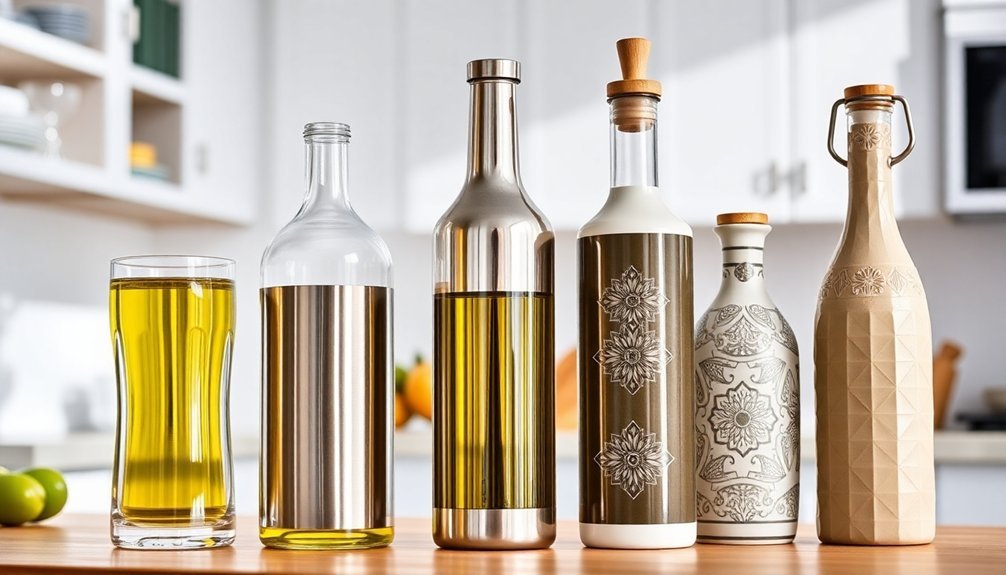
When storing oils properly, selecting the right bottle material is essential for maintaining quality and preventing spoilage. You'll want to choose glass bottles over plastic bottles, as they provide superior protection and won't react with your oils.
Glass creates an airtight seal that keeps your oils fresh, while plastic can allow air to seep in and compromise quality.
For ideal oil storage, select amber-colored glass bottles, which shield your oils from harmful UV rays that accelerate oxidation.
While cobalt blue, green, and violet glass bottles are attractive alternatives that also protect against light exposure, avoid clear glass containers for long-term storage.
Don't use LDPE plastic bottles, as they're prone to leaking and can deteriorate when exposed to essential oils over time.
Light Protection Strategies for Essential Oil Bottles
To protect your essential oils from harmful UV rays, you'll want to store them in dark amber or cobalt blue glass bottles that naturally block light exposure.
If you're using specialized storage, consider UV-blocking essential oil cabinets or containers designed specifically for maintaining oil quality.
For maximum protection, combine dark glass bottles with additional light-blocking solutions like blackout curtains or dedicated cupboard space away from direct sunlight.
Dark Glass Bottle Benefits
Dark glass bottles serve as vital guardians for your precious essential oils, protecting them from harmful UV light exposure.
When you store your oils in amber or cobalt blue containers, you'll prevent oxidation and maintain their therapeutic properties longer. These specialized bottles block damaging rays that can trigger chemical reactions, keeping your essential oils potent and aromatic.
- You'll feel confident knowing your valuable oils are safe from degradation
- You'll appreciate the beautiful, professional appearance of your collection
- You'll save money by extending your oils' shelf life considerably
Dark glass protection is particularly important if you're working with citrus or floral oils, as they're especially vulnerable to light damage.
UV-Protective Storage Solutions
Protecting your essential oils from UV damage requires a multi-layered approach beyond just dark glass bottles. You'll want to combine proper storage techniques with the right glass containers to maximize protection.
| Container Type | UV Protection | Best Use |
|---|---|---|
| Amber Glass | 99% | Long-term storage |
| Cobalt Blue | 75-85% | Medium-term storage |
| Green Glass | 65-75% | Short-term storage |
Select amber glass bottles as your primary storage solution, as they offer superior UV protection compared to other options. For additional safeguarding, store your oil collection in a dark cupboard or use blackout curtains in your storage area. Never keep essential oils in clear glass containers, as they'll quickly degrade from light exposure. This thorough approach to proper storage guarantees your oils maintain their potency and therapeutic properties for their intended shelf life.
Light-Blocking Container Options
When choosing containers for essential oils, light-blocking properties should be your top priority for preserving their therapeutic value. Amber and cobalt blue glass bottles provide excellent protection against harmful UV rays that can quickly degrade your precious oils.
These specialized light-blocking containers prevent oxidation and maintain the oil's potency through effective UV filtration.
- Your oils' therapeutic benefits remain intact when stored in dark glass bottles, ensuring you get the full value from your investment.
- You'll experience peace of mind knowing your essential oils are protected from degradation in proper light-blocking containers.
- You can maximize your oils' shelf life by combining protective bottles with dark storage spaces.
For best results, avoid clear glass bottles and always store your oils in a cool, dark place away from direct sunlight and heat sources.
Temperature Control Methods for Oil Preservation
You'll want to store your cooking oils at temperatures between 55-60°F to maintain their quality and prevent spoilage.
While some oils like sesame and coconut benefit from refrigeration, you should keep them in airtight containers to preserve their texture and prevent moisture absorption.
To protect your oils from damaging heat exposure, never store them above your stove or near appliances that generate warmth.
Ideal Storage Temperature Ranges
Maintaining the right storage temperature for your cooking oils is essential for preserving their quality and extending their shelf life. To properly store cooking oil, keep most varieties between 55-60°F (13-16°C).
Extra virgin olive oil needs slightly warmer conditions at 65°F (18°C) to maintain its delicate properties. If you're storing heat-sensitive oils like sesame or nut varieties, your refrigerator can help achieve a longer shelf life.
- You'll save money by preventing oil spoilage through proper temperature control.
- You'll protect your family's health by avoiding rancid oils that can be harmful.
- You'll enhance your cooking results by maintaining oils at their peak freshness.
Keep your oils in a dedicated pantry or cupboard away from your stove and oven, where temperature fluctuations can quickly degrade their quality.
Cold Vs Room Storage
Although both cold and room temperature storage have their merits, choosing the right method depends on your specific type of oil.
You'll want to refrigerate heat-sensitive oils like sesame, nut, and citrus varieties to extend their shelf life and prevent oxidation. The ideal cold storage temperature ranges between 55-60°F.
However, oils high in saturated fats, like coconut oil, can be properly stored at room temperature in a cool, dark place.
If you're storing extra virgin olive oil, keep it in a cupboard away from direct sunlight and heat sources.
Remember that temperature fluctuations can speed up rancidity, so maintain consistent conditions wherever you store your oils.
Avoid placing them near your stove or other heat-generating appliances, regardless of whether you choose cold or room temperature storage.
Heat Damage Prevention
Proper temperature control stands as the first line of defense against heat damage in cooking oils. To store your oils effectively, maintain temperatures between 55-60°F in a cool environment, away from your stove and oven areas.
Using dark glass containers provides essential protection against both heat and light exposure, which can trigger premature oxidation.
- Your precious oils are literally *cooking* themselves when exposed to high temperatures – protect your investment!
- Think of your oils as living ingredients that suffer when stored near heat sources.
- Remember that every degree above ideal temperature *shortens* your oil's lifespan.
For heat-sensitive varieties like sesame and nut oils, don't hesitate to use your refrigerator.
While this might temporarily alter their texture, it's far better than letting heat damage compromise their quality and freshness.
Proper Sealing Techniques to Prevent Oxidation
To keep your cooking oils fresh and flavorful, you'll need to master a few essential sealing techniques that prevent harmful oxidation. Always make sure you're properly closing bottle caps after each use, as even minimal air exposure can trigger oxidation and rancidity.
Switch to dark glass containers instead of plastic ones for ideal storage. Glass provides an airtight seal that plastic can't match, while dark-colored bottles protect against damaging light exposure.
For premium protection, particularly with delicate nut oils, consider vacuum sealing unused portions. This removes air completely, extending the oil's shelf life considerably.
Don't forget to inspect your bottle caps and seals regularly. If they're worn or damaged, replace them immediately to maintain an airtight environment.
These simple steps will help preserve your oils' quality and taste.
Safe Handling and Transfer of Essential Oils
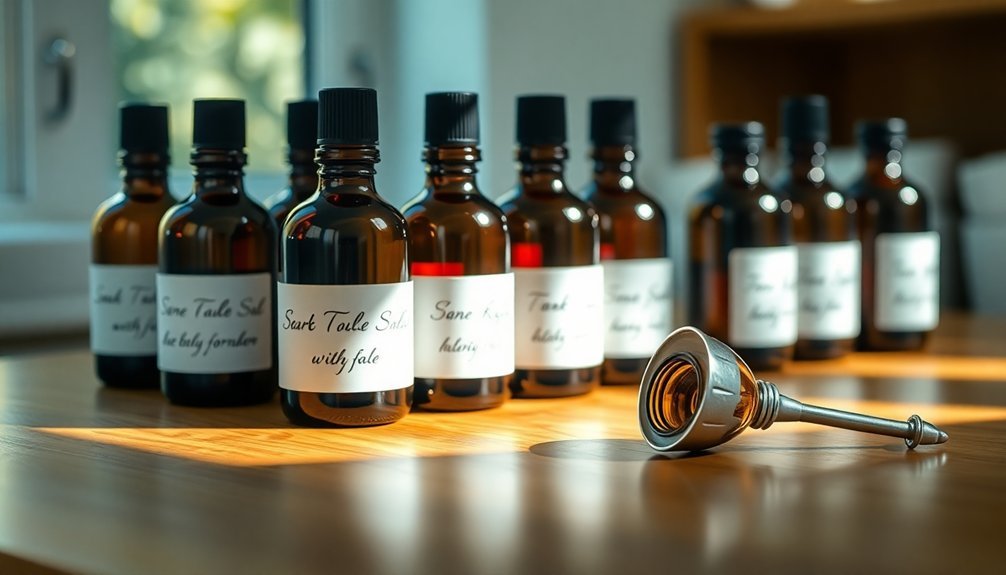
When transferring essential oils, you'll want to use specialized tools like droppers or dipulators to prevent messy spills and guarantee precise measurements.
Your choice of transfer tools directly impacts both safety and accuracy, making it vital to select equipment designed specifically for essential oil handling.
You can minimize waste and protect yourself from skin contact by using appropriate pouring aids, such as orifice reducers or dropper caps, which provide controlled dispensing of these concentrated substances.
Prevent Spills While Pouring
Safe handling of essential oils starts with mastering proper pouring techniques to prevent costly and potentially dangerous spills.
Using a dropper insert or dipulator will give you precise control when measuring, while specialized containers with built-in spouts guarantee smooth transfers.
Always work over a paper towel to catch any accidental drips and protect your workspace.
- You'll feel more confident knowing your precious oils won't go to waste when you use proper pouring tools.
- You'll experience peace of mind working over a protected surface that catches unexpected spills.
- You'll avoid the frustration of cleaning up messes by keeping bottles away from counter edges.
Pour oils slowly and steadily into stable containers, and you'll maintain control throughout the transfer process.
These simple preventive measures will help safeguard your investment and workspace.
Choose Right Transfer Tools
Selecting proper transfer tools stands at the forefront of essential oil handling safety.
You'll want to prioritize glass pipettes over plastic ones, as they're easier to clean and won't react with your essential oils. For precise measurements, use calibrated syringes with disposable tips to prevent contamination when blending different oils.
Instead of built-in orifice reducers, opt for bottles with polycone-lined caps to create a better seal and protect your oils from air exposure.
Don't forget to incorporate dropper inserts or dipulators for accurate dispensing and spill prevention.
Remember to maintain your transfer tools by cleaning them thoroughly after each use – wash them well and rinse with ethanol to avoid cross-contamination between oils.
These practices will help preserve your oils' quality and guarantee safe handling.
Storage Location Best Practices
To maximize the shelf life of your cooking oils, choosing the right storage location is essential.
You'll want to store cooking oils in a cool, dark pantry away from your stove and windows, maintaining an ideal temperature between 55-60°F.
Select a cabinet that's distant from heat-producing appliances, and use airtight glass containers to protect against oxygen exposure.
- Don't let your precious oils go to waste by placing them above the stove – that's where heat rises and can quickly turn them rancid!
- Keep your favorite oils fresh and flavorful by creating a dedicated storage space in your coolest pantry corner.
- Save money and protect your investment by avoiding the common mistake of storing oils in sunny spots or near appliances.
Bottle Cleaning and Maintenance Guidelines
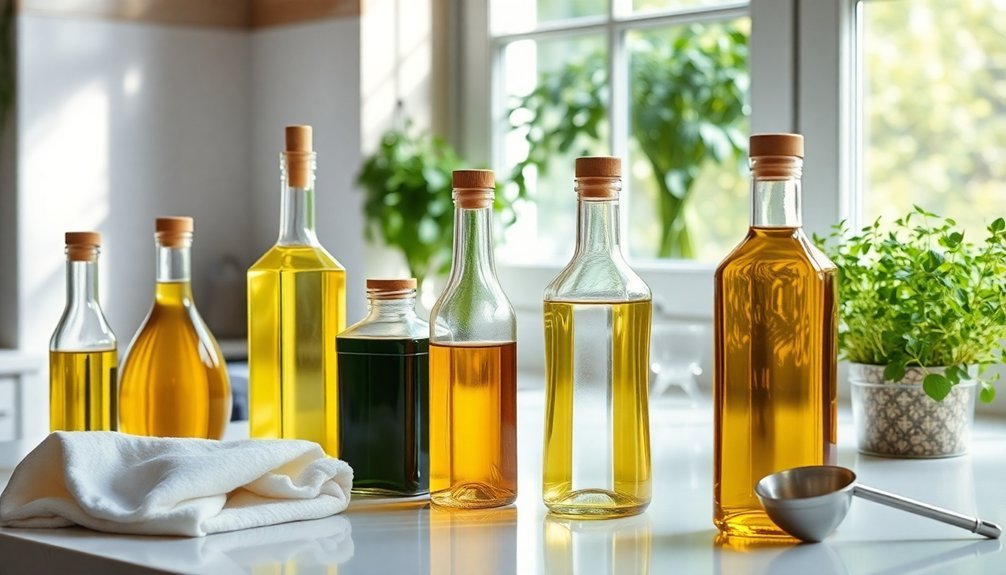
Maintaining clean storage containers is essential for preserving oil quality and preventing contamination.
You'll want to wash your glass pipettes in the dishwasher for thorough sanitation, but first rinse them with ethanol to remove any old oil residues that could trigger unwanted chemical reactions.
Keep an eye on your rubber droppers, as they can deteriorate when exposed to oils over time.
Replace them promptly if you notice any signs of wear.
When selecting storage containers, choose materials that won't degrade when in contact with your oils.
For safe disposal of broken glass pipettes or containers, use old liquor bottles as a secure collection method.
Cross-Contamination Prevention Measures
When handling multiple types of oils, preventing cross-contamination is essential for maintaining their individual properties and usefulness. To store oils safely, you'll need to implement a systematic approach that includes using dedicated, clean utensils for each type and keeping them in properly labeled, airtight glass containers.
Color-coding your storage system helps you quickly identify different oils and prevents accidental mixing.
- You'll feel more confident knowing your oils remain pure when you avoid transferring oils between containers unnecessarily.
- You'll experience peace of mind with a well-organized storage system that eliminates the risk of mixing up oils.
- You'll protect your investment by regularly inspecting oils for signs of contamination.
Always check for unusual odors or cloudiness before use, and discard any oils showing these warning signs to maintain the quality of your entire collection.
Bottle Labeling and Documentation Systems
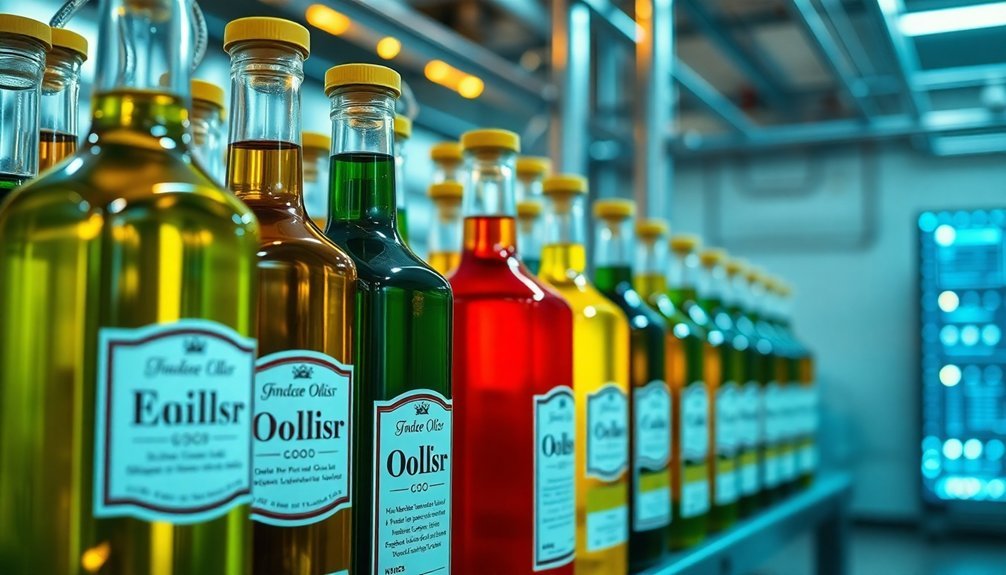
Since proper organization is crucial for safe oil storage, establishing a robust bottle labeling and documentation system should be your top priority.
Start by implementing waterproof, fade-resistant labels that clearly display the oil type, purchase date, and expiration date on each container.
You'll want to color-code your bottle labeling system for different oil varieties, making it easier to identify and retrieve the right product quickly.
Keep a detailed documentation log tracking your purchases, usage patterns, and any quality observations. This will help you make informed decisions about future purchases and maintain ideal storage conditions.
Don't forget to review and update your storage documentation regularly.
Emergency Spill Management for Oil Containers
Proper spill management preparation can mean the difference between a minor incident and an environmental disaster.
You'll need to keep a spill kit with absorbent materials close to your oil containers at all times. Regular inspections of your containers for damage will help prevent unexpected leaks, while clear labeling guarantees you can respond quickly when issues arise.
When you encounter a spill, act fast to contain it using barriers and absorbent materials.
Remember to dispose of contaminated cleanup materials properly as hazardous waste.
- The sinking feeling when you discover an oil leak spreading across your floor
- The relief of having the right tools ready when seconds count
- The confidence that comes from knowing you're prepared for any emergency
Frequently Asked Questions
How Should Oils Be Safely Stored?
You'll want to store your oils in sealed glass containers, keeping them in a cool, dark place at 55-60°F. Don't expose them to heat, light, or oxygen, and check regularly for spoilage signs.
Is It OK to Store Oil in Plastic Bottle?
While you can store oil in plastic briefly, it's not ideal. You'll want to use HDPE or PP food-grade containers if necessary, but glass bottles are your best choice for maintaining quality and safety.
What Is the Best Container for Storing Oil?
You'll get the best results storing oil in dark-colored glass containers with airtight lids. Choose amber or cobalt blue bottles as they'll protect your oil from UV light and won't react with the contents.
How to Store Essential Oil Bottles?
Store your essential oils in amber or cobalt blue glass bottles, keep them tightly sealed, and place them in a cool, dark spot between 60-70°F. You'll want to refrigerate citrus oils specifically.
In Summary
Protect your investment in essential oils by implementing these storage best practices. You'll extend your oils' shelf life and maintain their therapeutic properties when you're diligent about proper bottling, protection from light and heat, and careful handling procedures. Remember to label everything clearly and keep your storage area organized. With these ten tips, you're now equipped to safely store and preserve your essential oil collection.
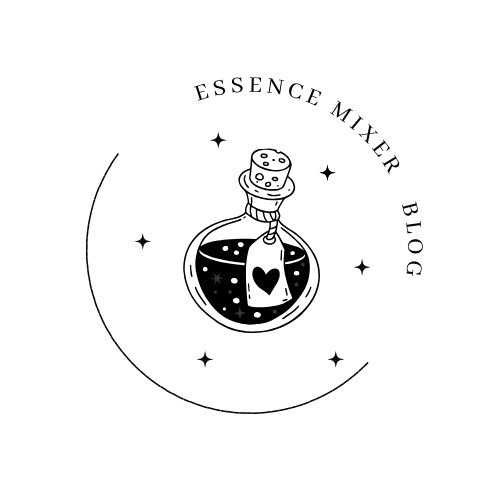
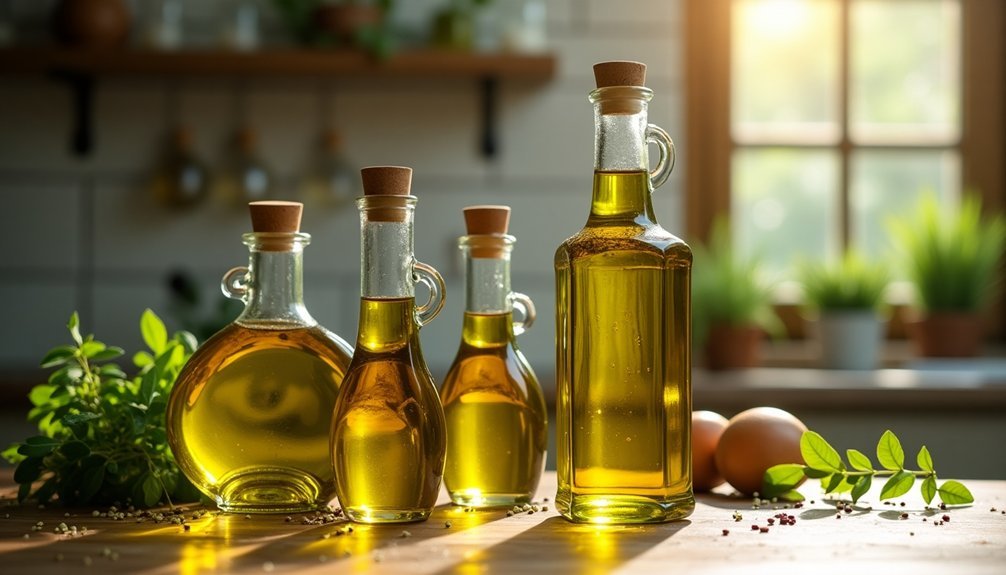



Leave a Reply